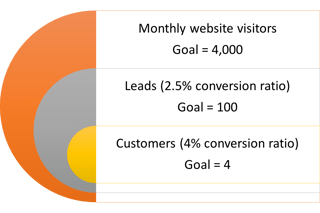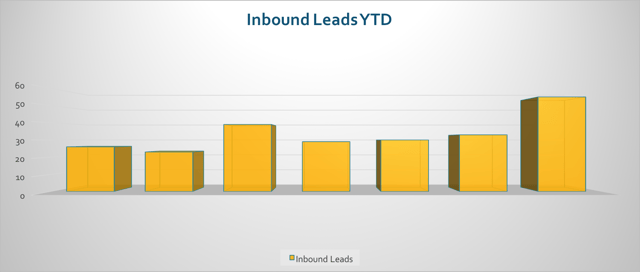
One of the benefits of sales and marketing technology is that you can measure just about everything you do. Whether it's email open rates, website visits or conversion rates, you can measure it. Just because you can measure it doesn't mean you should. The best thing you can do to use marketing analytics to sell way better is to measure the right things.
Inbound marketing lead generation funnels are relatively straightforward. Here's a graphical depiction of an inbound lead generation funnel for a typical SMB professional services firm.

Although the numbers may change depending on the type of business, the relationships that result in revenue are consistent. A certain percentage of website visitors will become leads (lead conversion ratio) and a certain percentage of those leads will become customers (customer conversion ratio.)
A SMART Goal-Setting Process For Business Development And Growth
3 marketing analytics tips for business owners
Tip #1: Don't Chase Vanity Metrics
Many people make the mistake of focusing on metrics like Facebook likes and LinkedIn shares. While these metrics may eventually funnel down to revenue, in general, a Facebook like and $3.75 will buy you a Latte at Starbucks. It's important to understand your fundamental marketing funnel and how things like Facebook likes impact it. For example, if someone likes your post on Facebook and then comes to your website, they may be a potential buyer at the very beginning of a buying process. But the value of the "like" itself is intangible - it may have some small positive impact on your SEO, but it's not something with an immediate impact on generating revenue.
Tip #2: Consider Quality In Your Analytics
All leads aren't created equal. In my business, I would much rather have 1 lead who is a business owner of a SMB professional services firm than 10 leads who are entry-level marketers at a large Fortune 500 company. The reason is simple - the business owner fits my ideal customer profile. Keep this in mind when reviewing your marketing analytics. One way to do this is to ask a profile question or two on your lead generation forms. Use simple drop-downs to make it easy on your potential buyer - if you give them too much homework they will bounce off your website. A bonus of this technique is that you can segment your audience for email and content promotion purposes. In my case, an email that would resonate with business owner probably wouldn't with the entry level marketers. The solution is to write 2 emails and send them to the appropriate audience.
Tip #3: Understand The Relationships Between KPIs When Making Business Decisions
If you only look at your KPIs from a short-term perspective, you could make the wrong business decision. Let's say that you're a cybersecurity consultant that just started a content marketing program to generate leads and enhance your authority within your industry. You look at the results in the first month and see that your blog generated a relatively small amount of website visits and no leads. If this is only considered from a short-term perspective, the business could decide to pull any more investment in content marketing because it's not close to producing positive ROI. When viewed from a long-term perspective, the business would realize that it takes some time to develop domain authority with Google and stick with the plan.
A Marketing Analytics Case Study
As some of you who've read our blog may know, we advocate strongly for a tightly focused sales and marketing approach for SMB businesses. As part of our planning for this year, we decided to eat our own dog food and really focus on our target market, which is SMB companies in the information sector - technology companies, professional service businesses and high-tech manufacturers.
As part of that strategy, we chose to publish far less "generalist" content about sales and marketing and to solely focus on creating content for our target market. Here's our statistics so far this year for website visits and inbound leads.
Website Visits

Leads

At first blush, these results may seem disappointing - website visitors are down from the beginning of the year! But we're very happy with the results. Let me explain.
When we changed our content strategy, we focused on a much smaller audience - our ideal customers. Although there is some seasonal variation to be expected, our website traffic is down from the beginning of the year. Our hypothesis is that this is because we're targeting a much smaller audience. When we publish "The 4 Essential Elements Of A Technology Sales Process," we're very aware that we're limiting our audience - it's a conscious intent.
Our lead generation stats lead us to believe that we're on the right track. We generated 55 leads in July, which is a 70% lift from January. 14 of those 55 leads were Sales Qualified Leads (leads that meet our criteria and which we're pursuing.) This has given us a nice boost to our sales pipeline, which will hopefully get us where we need to be by the end of the year.
A SMART goal-setting and monitoring process will keep you on the right track, allowing you to adjust course to avoid unpleasant surprises. The key is knowing which metrics matter and how the tactics you employ impact them.







